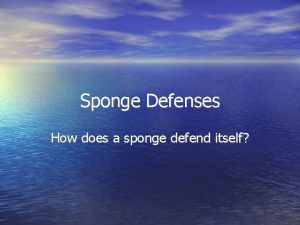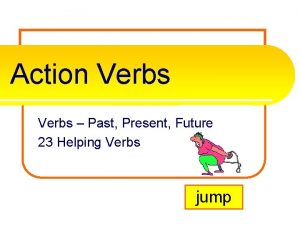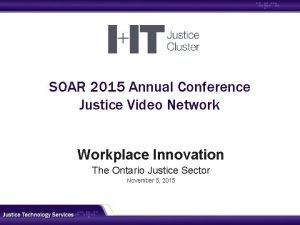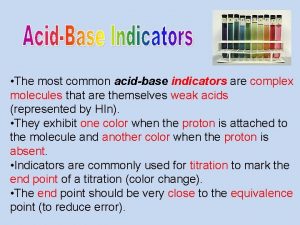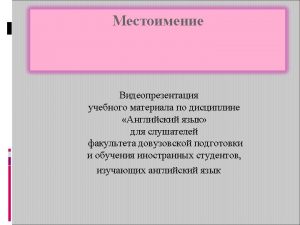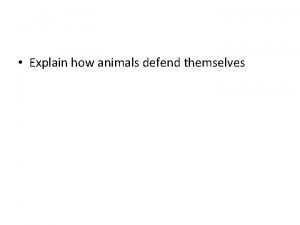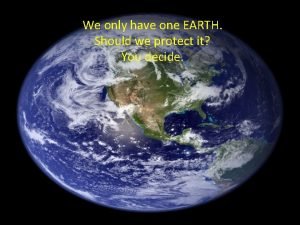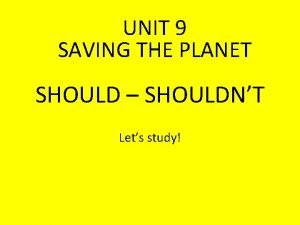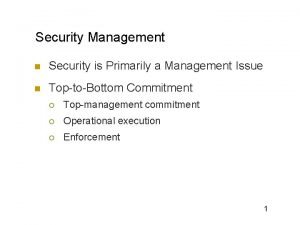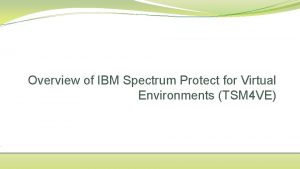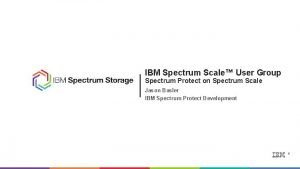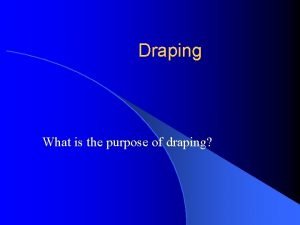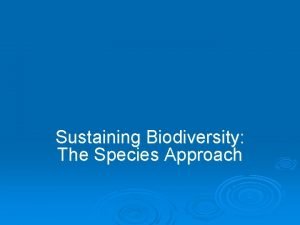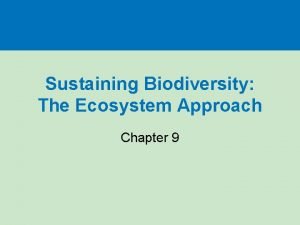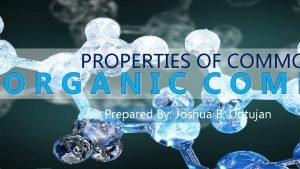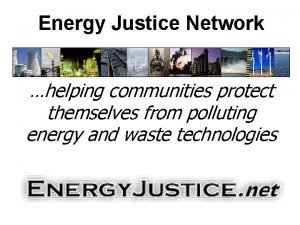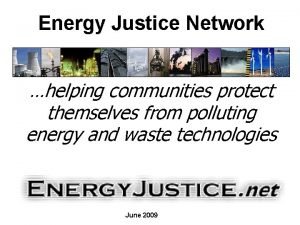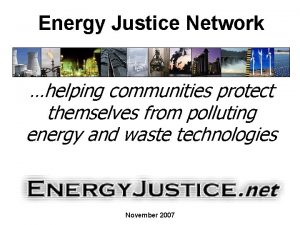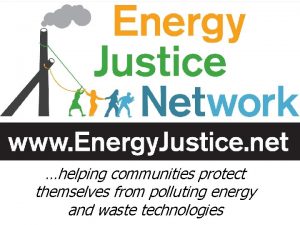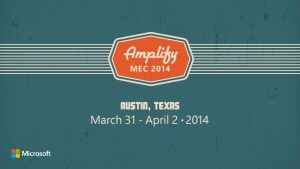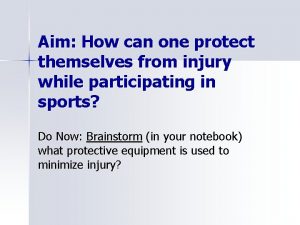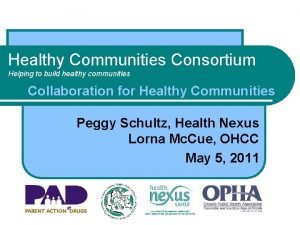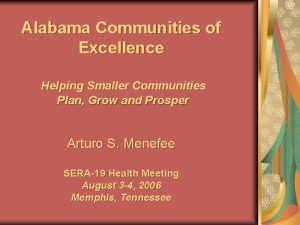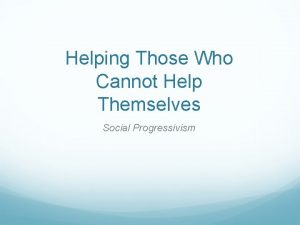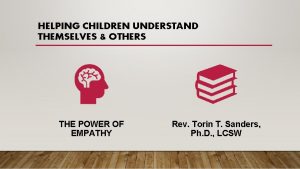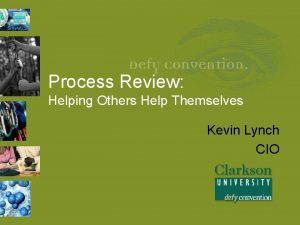Energy Justice Network helping communities protect themselves from





































- Slides: 37

Energy Justice Network …helping communities protect themselves from polluting energy and waste technologies Sept 2013

Landfill Gas www. energyjustice. net/lfg/


All Landfills Leak • U. S. EPA acknowledges that all landfill liners leak within 20 years, if not sooner • Landfill liners are only guaranteed for about 20 years • Landfills are permitted to leak a certain amount of gallons/acre • It's easy not to find leakage (underground or in air); testing is often inadequate

Landfill Gas: What it is… • Not simply “methane” • About half methane, half CO 2 • Organics breaking down create the methane; methane helps the toxic chemicals escape • Hundreds of toxic contaminants – Halogenated compounds (trichloroethane, vinyl chloride, carbon tetrachloride and many more) – Mercury (methylmercury – the really bad kind) – Sulfur compounds (the stinky stuff) – Tritium (radioactive) – Other toxic organic compounds (benzene , toluene…)


Global Warming Pollution Smokestack CO 2 Emissions from U. S. Power Plants in pounds of CO 2 per unit of energy produced (lbs/MWh) Source: U. S. EPA e. GRID 2012 Database

Landfills Worse for Climate than Incinerators • Study: if landfill gas capture rates are in the 50% to 70% range, their GHG impact is about the same as incinerators. • Capture rates are lower, making incinerators worse • Study used old global warming potential for methane, further underestimating GHG landfill impacts Source: Jeffrey Morris, “Bury or Burn North America MSW? LCAs Provide Answers for Climate Impacts & Carbon Neutral Power Potential, ” Sound Resource Management Group (2010).

Landfill Gas: Capturing it • Gas capture requirements based on toxics (“non-methane organic compounds” or NMOCs), not greenhouse gas emissions • Landfills that estimate releasing over 55 tons/year of NMOCs must collect gas and reuse or “destroy” 98% of them

Landfill Gas: Options • • Flare Internal Combustion Engine (electricity) Turbine (electricity) Boiler (heat/steam) Piping into natural gas lines Hydrogen production Reuse of chemicals (methane and CO 2) for industrial feedstocks

Landfill Gas-to-Energy Emissions • For some chemicals, burning for electricity is more polluting than flaring – Carbon monoxide – Nitrogen oxides (NOx) – Sulfur dioxide (SO 2) – Methane – Dioxins – Methylmercury 2. 7 times worse 2. 6 times worse 3% worse 41% worse (depends on differences in capture rate) • Burning halogenated compounds creates significant amounts of dioxins/furans

Landfill Gas – Proper Management 1) Ban organic wastes from landfills Clean compost from food scraps and yard waste (not sewage sludge!) can be used in gardening or landscaping. The organic fraction of unsorted trash (after recyclables are removed) should be digested, then monofilled (placed in separate landfill cells), as it’ll be too contaminated. • • • There is no methane in your trash can. Europe and Latin America know to keep organics out of landfills. World Bank and International Panel on Climate Change agree. U. S. EPA ignored this advice. Some communities are canceling composting programs to get more organics into their landfills

Composting Collection at a Brazilian Mall Food Court

Landfill Gas – Proper Management 2) Minimize gas production. Maximize gas collection. Do not manage the waste facility as an energy facility by stimulating gas production and increase methane concentration, as more will be released uncaptured (capture rates are not 100%). • Filter the toxins in the gas into a solid medium like a carbon filter. The carbon filters ought to be containerized and stored on-site. – • Landfills usually filter only sulfur, water vapor and siloxanes They should not go to a carbon “regeneration” or “recycling” facility, since they simply incinerate the chemicals – letting them back out into the environment by burning them out of the filters.

Landfill Gas – Proper Management 3) Once the gas is purified… it may be acceptable to burn it for steam or electricity, however, this may not be possible without mismanaging the landfill and releasing more gas. Other alternative technologies include piping it into natural gas lines, producing hydrogen or segregating the CO 2 and methane to be sold as industrial chemical feedstocks.

Landfill Gas – Proper Management 4) Landfill gas use for energy should not be considered renewable, since that allows it to compete with (and undercut) clean sources like wind power. Subsidizing landfill companies also puts source reduction, reuse, recycling and composting at a competitive disadvantage.

Landfill Gas: Only 10 -15% Captured • About ½ of landfills not required to capture • About ½ of gas produced when no capture mechanism is in place • About ½ of the gas collected when collecting gas


More Gas = More Gas Leakage • A study of women living near 38 New York landfills where gas is escaping found a significant four-fold increased risk of bladder cancer and leukemia. • More exposure to methylmercury and hundreds of other toxins.

Landfill Gas & Global Warming • Industry claims 95 -99% capture rate in closed cells • EPA researchers found 3888% at the best landfills (the most well-managed ones where landfill operators volunteered to be studied) • Front-loading methane generation = more methane leaking out sooner = global warming danger Methane = 105 times more potent than CO 2 over a 20 year timeframe

Bioreactors = Degrading the Cap • Landfills are designed to be “dry tomb” facilities (avoiding moisture and gas generation). • Wet landfills (bioreactors) cause accelerated decomposition – Creates more airspace so more waste can be dumped over time – Enormous and quick subsidence will crack cap – Replacing cap: $125, 000/acre (who pays? )

Landfill Gas: Mercury • Mercury Emissions Comparable to Coal Power Plant Exhaust • Landfills are one of two known sources of methylmercury (the fat-soluble kind) – Other source is sewage sludge • Burning reduces it back to elemental mercury, but since most isn’t burned, most escapes in its methylated form

Landfill Gas: Mercury

Dioxin Facts • Dioxins and furans are the most toxic chemicals known to science. They are highly toxic even in miniscule amounts. • Dioxins cause infertility, learning disabilities, endometriosis, birth defects, sexual reproductive disorders, damage to the immune system, cancer and more. • 93% of dioxin exposure is from eating meat and dairy products. www. ejnet. org/dioxin/

Exposure to Dioxins

How to make dioxin • Dioxins are created by burning hydrocarbons (methane) with chlorine (present in landfill gas) in the presence of oxygen. • Dioxin emissions increase when: – More chlorine is in the fuel/waste stream – Certain metal catalysts are present – The gases stay in a low temperature range (200 -450 o C)

Renewable Fuel Standard (RFS 2) • Sets mandate for use of cellulosic ethanol and other “advanced biofuels” • Not enough cellulosic ethanol to meet standard; RPS 2 could collapse • EPA’s way to keep it alive: subsidize landfills • EPA aiming to allow landfill gas to energy technology to meet RFS 2 obligations


Zero Waste Hierarchy • • Rethink / Redesign Reduce Reuse Recycle Compost Research Stabilize (digest) / Monofill and manage properly

Zero Waste Hierarchy (1/6) • Redesign – Make products durable, recycled and recyclable – Use materials which are more environmentally sustainable • Reduce – Toxics Use Reduction – Reduce amounts of toxic chemicals in production – Replace toxic chemicals with less toxic or non-toxic alternatives • Consumption Reduction – – Use less Buy less (reduce advertising) Buy stuff with less packaging Avoid disposables & non-recyclables • Packaging Reduction – includes styrofoam bans and single-use paper/plastic bag bans and taxes

Zero Waste Hierarchy (2/6) • Reuse/Repair – – – Thrift stores Charity collections Dumpster diving Freecycle Paint blending Repair centers for bikes, computers/peripherals, furniture, appliances, etc. • Recycle – source-separation, not single stream – seek the highest end-use and avoid "downcycling"; segregate office paper from lower paper grades and other recyclables, to keep quality high – buy recycled; create market for glass so that glass collected for recycling is actually recycled, not dumped in landfills – adopt a bottle bill / wastepicking

Zero Waste Hierarchy (3/6) • Compost – Curbside collection of organics (weekly), which can be done while decreasing the collection of trash and recyclables to biweekly (the smelly stuff in trash is the compostable stuff, so this encourages people to compost if they don't want trash smelling). – Ban clean organics (not sewage sludge!) from landfills. Sewage sludge, even after being digested, does not belong on farm fields or in urban gardens. – Clean compost from food scraps and yard trimmings can be used in gardening or landscaping. • Research – on a regular basis, do a waste sort and see what remains in the waste and feed that into Extended Producer Responsibility campaigns, product bans and other measures to eliminate these residual materials from the waste stream, ensuring that they're dealt with further up in this hierarchy

Zero Waste Hierarchy (4/6) • “Dirty” Materials Recovery Facility (MRF) for the remainder – pull out additional recyclable and compostable material. It's important that this not be a replacement for source separation and upstream recycling, as it will get people out of their good recycling habits and will degrade the quality of recyclables, lowering their value and ensuring less will actually be recycled. • Anaerobic digestion – The remainder, if there is enough organic material in it, should be digested in order to reduce the methane generating potential, stabilizing the waste • Monofill (landfill in separate landfill cells at existing landfills)

Zero Waste Hierarchy (5/6) • Ensure proper landfill management (don't mismanage the landfill by managing it for energy production) – Minimize gas production: Do not manage the waste facility as an energy facility by stimulating gas production. • Keep out liquids – Cover the active face of the landfill to keep out rainwater, using a temporary structure – Do not recirculate leachate • Cap landfills with permanent synthetic covers and install gas collection systems in months, not years. – Maximize gas collection: • Segregate organics in landfills for best gas collection • Maintain high suction on collection wells; do not damp down wells or rotate off the wells to stimulate methane production

Zero Waste Hierarchy (6/6) – Clean the gas prior to use • Filter toxins in the gas into a solid medium like a carbon filter; containerized and store on-site. – Do not send to carbon "regeneration" or "recycling" facilities [they simply incinerate the captured chemicals, polluting the air] – The purified gas can be used: • • • for heating purposes (burned in a high efficiency boiler), piped into gas lines, used to make alternative vehicle fuel, used in fuel cells, burned for electricity in a high efficiency turbine (less preferable to uses for heating), or • the CO 2 and methane can be segregated and sold as industrial chemical feedstocks (but not for food industry use). • Landfill gas-to-energy should not be considered renewable (That allows it to undercut clean sources like wind and solar and puts source reduction, reuse, recycling and composting at a competitive disadvantage. )

For more Info… • Incineration: – – www. Energy. Justice. net/incineration/ www. Energy. Justice. net/tires/ www. no-burn. org www. Green. Action. org • Landfills and Landfill Gas Burning: – www. Energy. Justice. net/lfg/ – www. ejnet. org/landfills – www. beyondlandfilling. org • Zero Waste: – – – www. Energy. Justice. net/files/technologies. pdf www. ilsr. org/initiatives/waste-to-wealth/ www. grrn. org/zerowaste/ www. zwia. org New Energy Justice zero waste page coming soon… email mike@energyjustice. net for resources by email until new page is up.

Energy Justice Network Mike Ewall Founder & Director 215 -436 -9511
 Camouflage is one way animals protect themselves
Camouflage is one way animals protect themselves Sponges defense mechanism
Sponges defense mechanism Are flamingos omnivores
Are flamingos omnivores Helping verbs past present future
Helping verbs past present future Hydrarch succession
Hydrarch succession Justice video network
Justice video network Energy energy transfer and general energy analysis
Energy energy transfer and general energy analysis Energy energy transfer and general energy analysis
Energy energy transfer and general energy analysis Intensive word
Intensive word Definition of a short story
Definition of a short story Indicators are complex molecules that themselves are
Indicators are complex molecules that themselves are The chain of being elizabethan
The chain of being elizabethan Yourself themselves
Yourself themselves How baby boomers describe themselves
How baby boomers describe themselves Elements of the setting
Elements of the setting Compiler
Compiler What are the characteristics of a greek sculpture
What are the characteristics of a greek sculpture 1 timothy 2:8-10
1 timothy 2:8-10 They devoted themselves to the apostles teaching
They devoted themselves to the apostles teaching Express themselves
Express themselves Motorcyclists can make themselves more visible at night by
Motorcyclists can make themselves more visible at night by How do animals defend themselves
How do animals defend themselves The ability of the muscles to repeatedly exert themselves
The ability of the muscles to repeatedly exert themselves How we can protect our environment
How we can protect our environment We have only one earth let's protect it
We have only one earth let's protect it Unit 9 saving the planet
Unit 9 saving the planet The plan-protect-respond cycle
The plan-protect-respond cycle Images
Images Ibm spectrum protect
Ibm spectrum protect Dot
Dot Ibm spectrum scale architecture
Ibm spectrum scale architecture Greek superstition
Greek superstition Reach 3 hali
Reach 3 hali When is a chemical draping used
When is a chemical draping used Ways to protect the ecosystem
Ways to protect the ecosystem Sustaining biodiversity the ecosystem approach
Sustaining biodiversity the ecosystem approach How to protect against rogue access points
How to protect against rogue access points Juan miguel wants to protect his bicycle parts from rusting
Juan miguel wants to protect his bicycle parts from rusting

